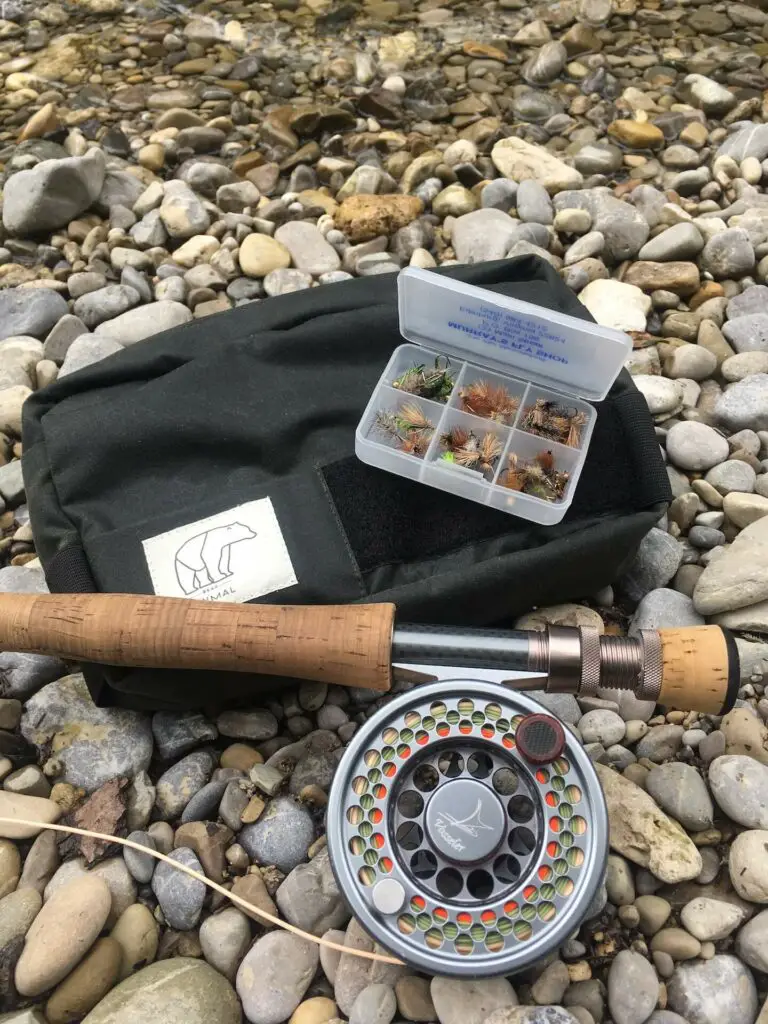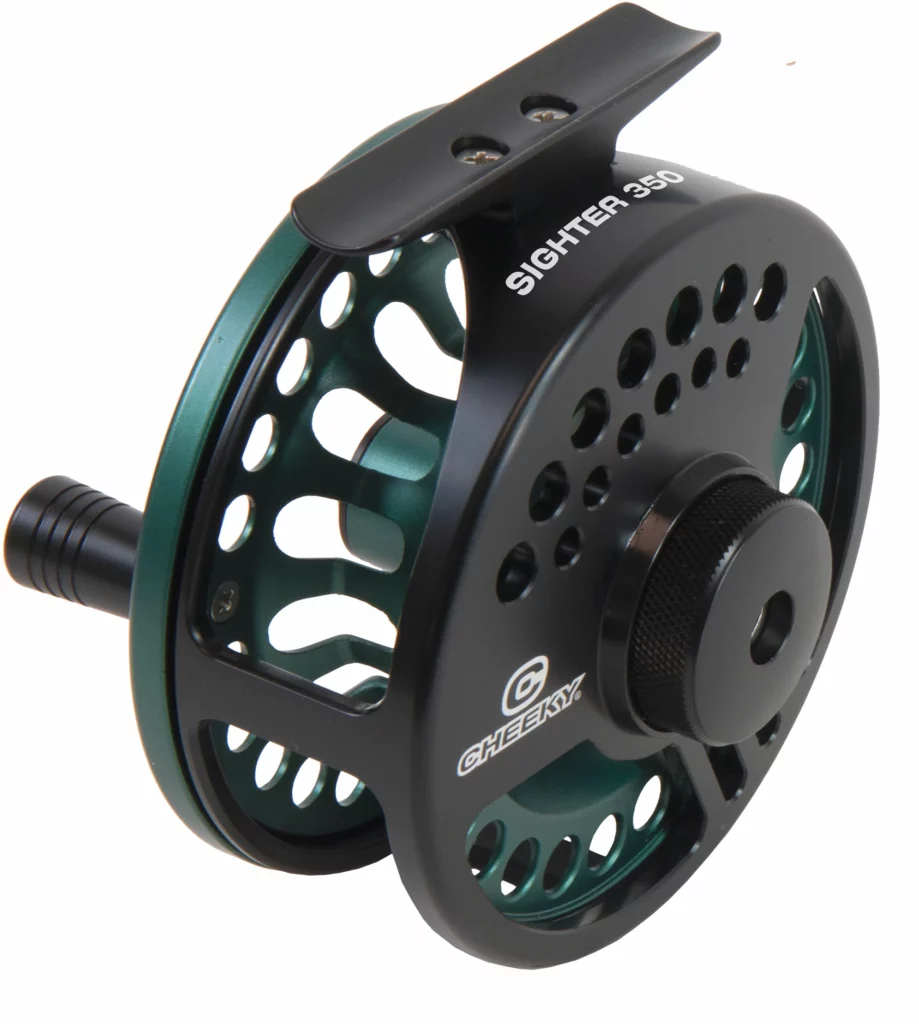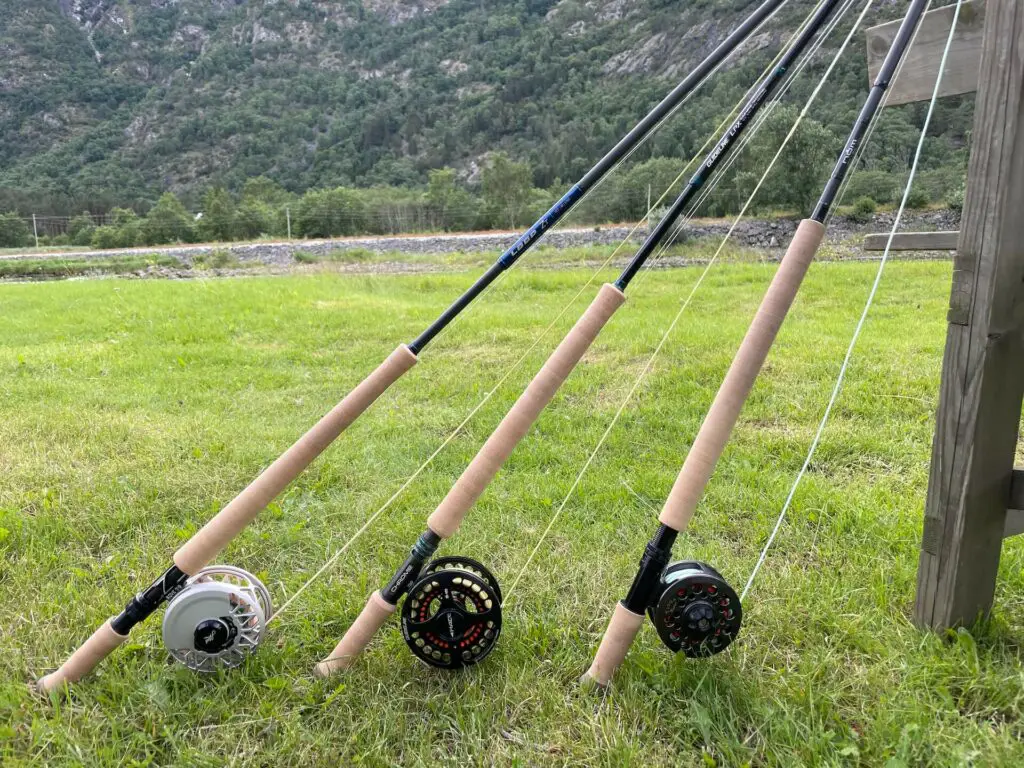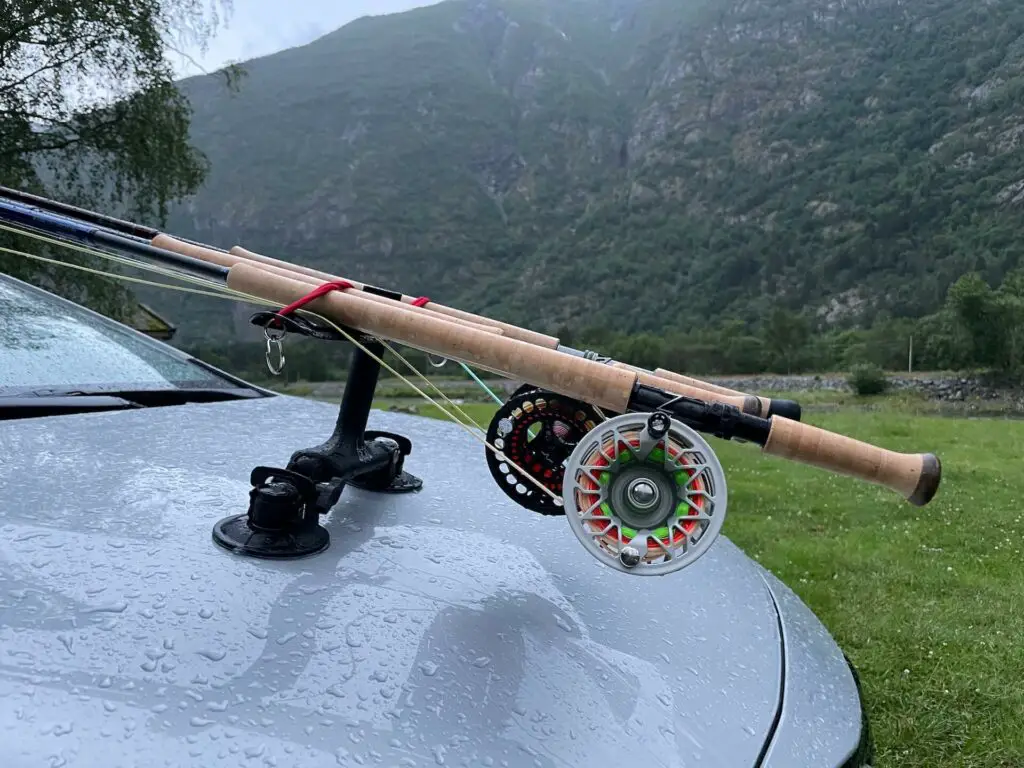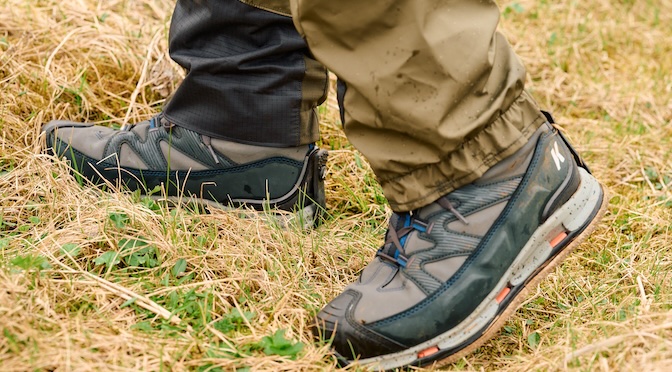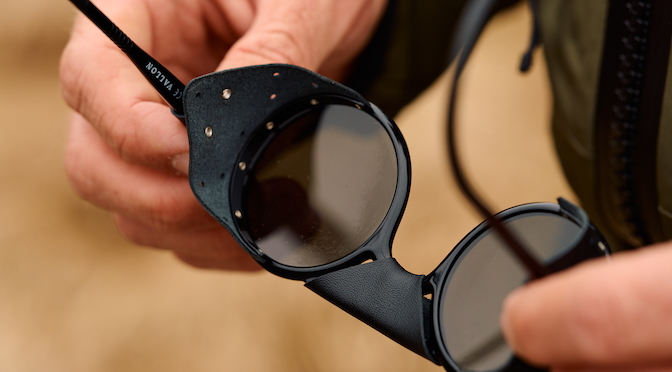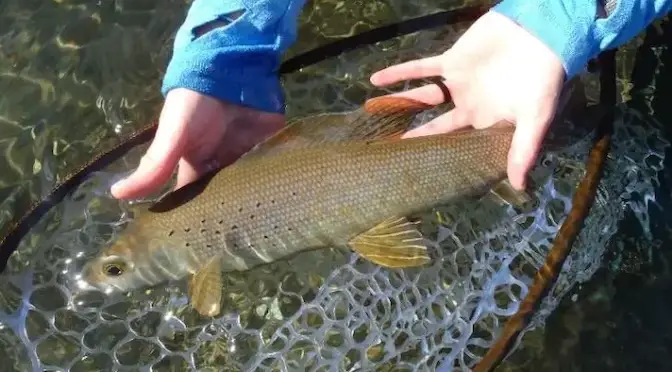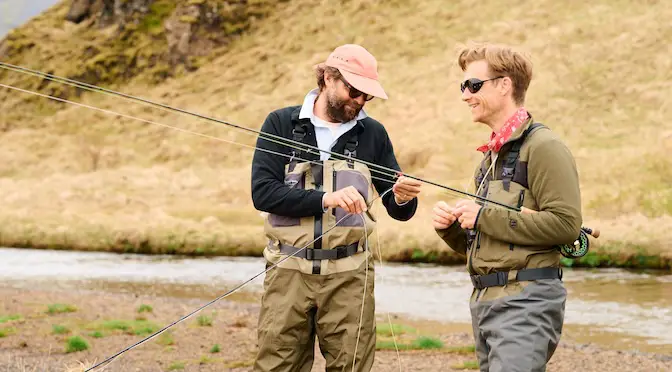Last updated on June 13th, 2025.
- Wading Wisdom #13 – Simon Gawesworth - July 7, 2025
- On the Water with the Korkers Bantam Lite - June 26, 2025
- How to Find Trout in Rivers & Streams Anywhere - June 13, 2025
As an advanced level professional, I understand the importance of choosing the right beginner fly reel for your fishing needs.
It can be tricky to settle on the right choice with so many different fly reels out there in 2023. In this article we will discuss some of the most important criteria when selecting a beginner fly reel such as the size of the reel, drag system and material used to construct it like aluminum or titanium (read our in-depth guide on fly reel pricing factors). We’ll also explore what species are best suited for beginning anglers looking to get into fly fishing such as trout or bass. Finally there will be a FAQ section and conclusion that wraps up our discussion on beginner fly reels.
Table of Contents:
7 Best Fly Reels for Beginners Quick Answer List
Introduction to the Best Fly Fishing Reels for Beginners
Best Beginner Fly Fishing Reels Reviewed
Important Features in Fly Reels for Beginners
Disclaimer: All products in this guide are independently researched by our team. We only recommend products we believe in and never get paid for the reviews. Learn more about our review process here.
7 Best Fly Reels for Beginners Quick Answer List
Best beginner fly reels of 2025
Introduction to the Best Fly Fishing Reels for Beginners
Fly fishing is a beautiful sport and your fly reel is definitely one of the most important components of your setup. When choosing a starter fly reel it’s important to know about the main features of fly reels such as the size of the reel, the drag system, and the material of the reel. The arbor size determines how much line can be stored on the spool, and a larger arbor can facilitate a quick line pick up when hooked into a fish to get it under control more quickly. There are two main types of drag systems: disc drag systems, which offer more power but less control, and click and pawl systems, which provide greater flexibility. Fly reels are made of different materials, including aluminum, steel, and titanium, each with its own advantages and disadvantages.
Overall, it is important to choose the reel size, drag system, and material that best suit your needs and preferences. If you want to dive deeper into these features, don’t worry, we’ve got you covered in the second part of our review. Now let’s take a look at some of the best starter fly reels on the market in 2025.
Best Beginner Fly Reels Reviewed
Here are our favorite starter fly reels of the season. We’ve made sure to include products with larger arbor and regular arbors, depending on your preference. (Read more about arbor size further down in our review).
Redington Crosswater Reel
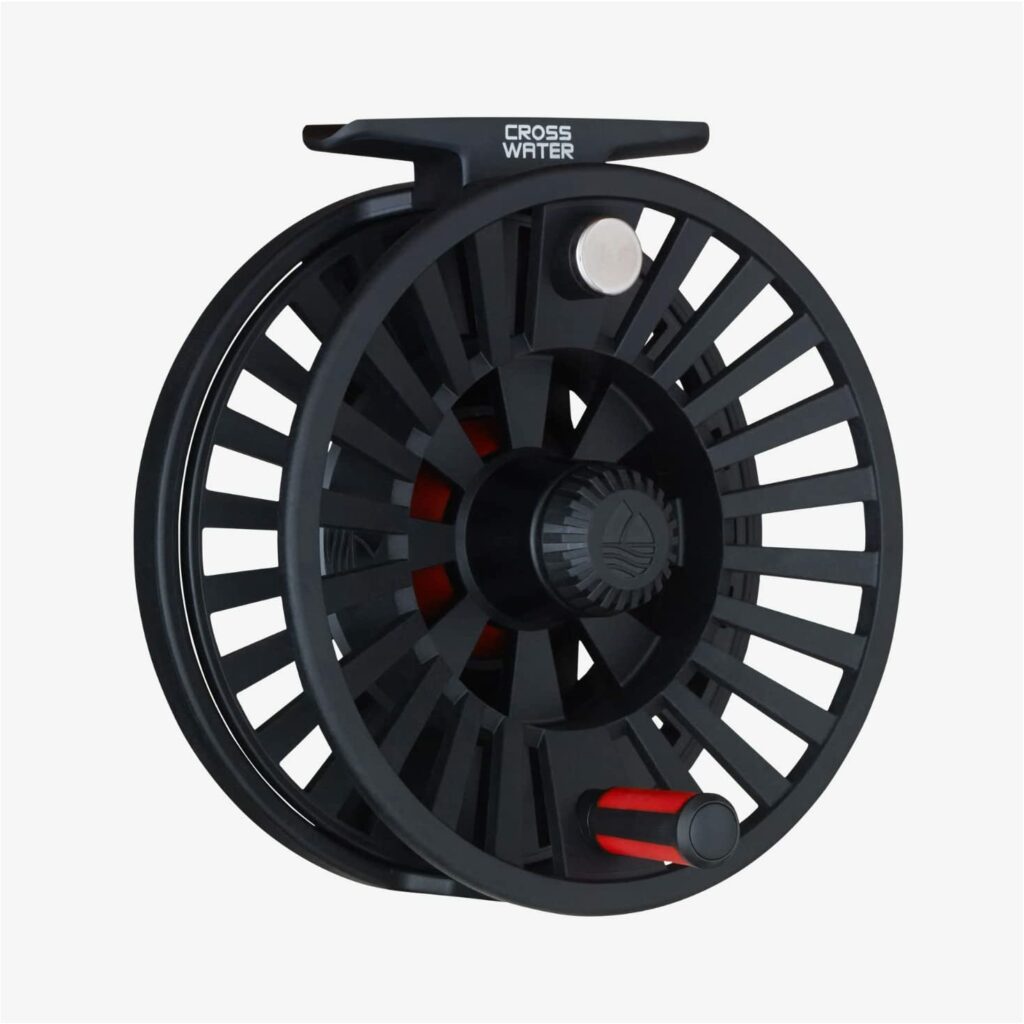
Specs: Comes in two sizes: 4/5/6 (great for trout) and 7/8/9 (great for big bass or pike). Diameter: 3.5 and 3.9 inches. Weight: 5.1 oz and 5.5 oz. Large arbor. Line capacity: 100yds/200yds
Why we picked it: The Redington Crosswater (read our in-depth review here) is a great choice for beginner fly anglers looking to get into the sport. This reel has all the features that you need to start out with, and it won’t break the bank either. The Redington can hold up to 100 yards of 20-pound backing line, making it perfect for targeting trout or bass in most freshwater environments.
It also has large arbor which gives you plenty of room for storing your line without having too much bulk on your rod. The drag system is smooth and reliable, allowing you to adjust tension as needed when fighting fish. The material used in the Redington Crosswater is a durable polymer fair which makes it lightweight yet durable enough for everyday use. Personally I like the all-black design as it gives it a minimalistic look.
The Redington Crosswater also offers good corrosion resistance so that you don’t have to worry about rusting over time from exposure to water or salt air if fishing near coastal areas. One thing we like about this reel is its affordability; at around $50 USD, it’s one of the best values on the market today when compared with other reels in its class.
Pros:
-
Affordable price point
-
Durable construction
-
Smooth drag system
Cons:
-
Not the lightest reel
-
A few more color options would be a nice feature
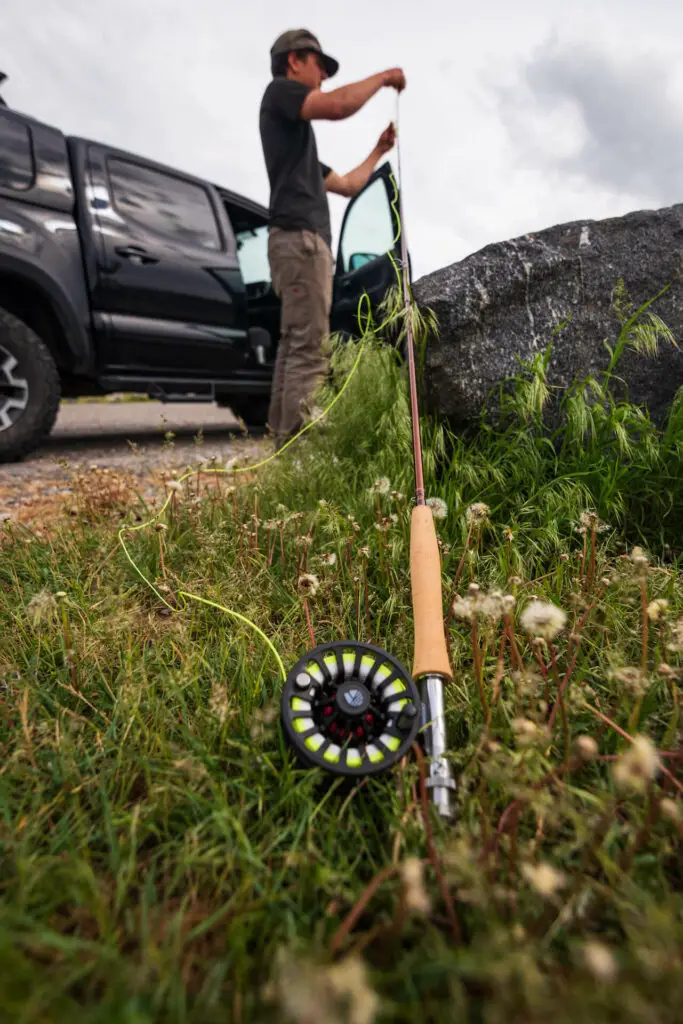
Orvis Clearwater Large Arbor Fly Reel
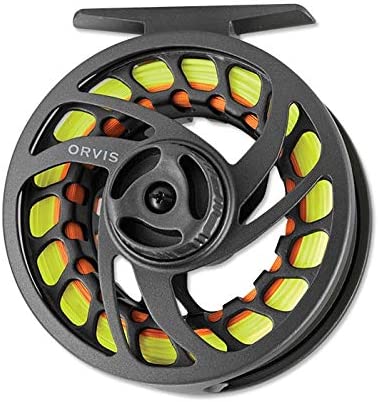
Specs: Comes in two sizes: II (4-6) and IV (7-9). Weight: 5.4 oz and 6.1 oz. Size: 3 1/2 inch and 3 3/4 inch diameter.
Why we picked it: The Orvis Clearwater (read our in-depth review here) is another rock solid option if you’re looking for starter fly reels. It has a large arbor design that allows for faster line retrieval, making it easier to land your catch. The reel is made from machined aluminum and features a corrosion-resistant finish, ensuring its durability in any environment. The drag system on the Clearwater is smooth and reliable, allowing you to fight even the toughest fish with ease. I always recommend buying products from a brand that also builds high end reels cause the knowledge tends to trickle down into the entry-level products. Such is the case with the Orvis Clearwater as well. It’s definitely a reel that you can use for years to come after starting out.
The Orvis Clearwater also comes with an adjustable spool tension knob so you can customize your setup according to the species of fish you’re targeting. In terms of size, this reel offers plenty of room for backing and line capacity without being too bulky or heavy. Its lightweight construction makes it easy to carry around all day while still providing enough power when fighting big fish.
Pros:
-
Orvis guarantee
-
Beautiful, straightforward design
-
Aluminum is very durable
Cons:
-
Only comes in one color
-
Extra spools are hard to come by for this reel
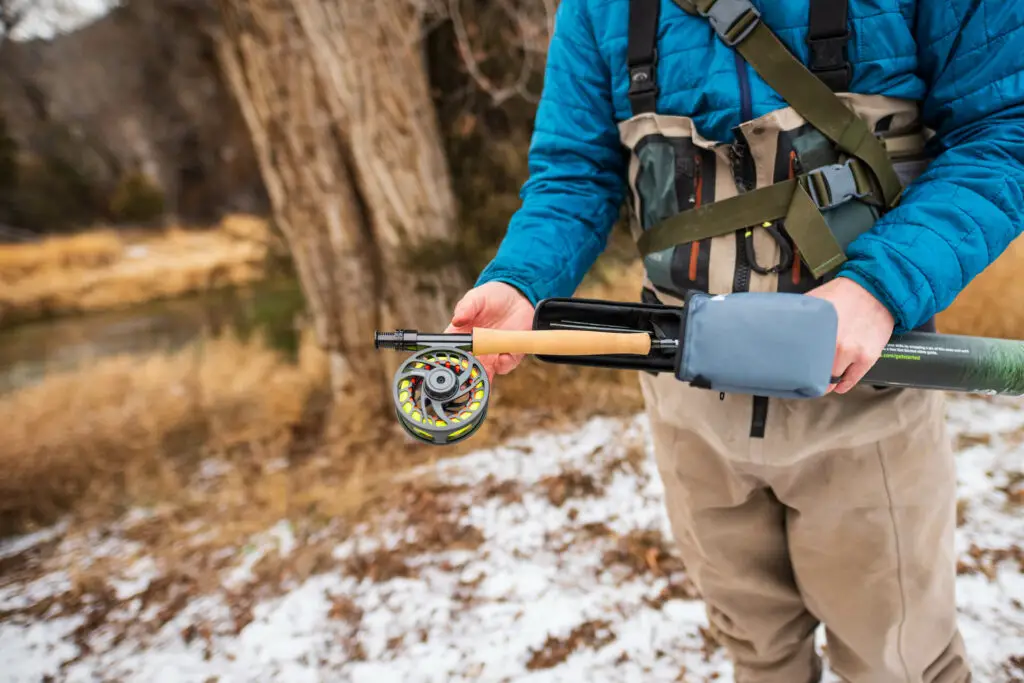
Echo Base Fly Reel
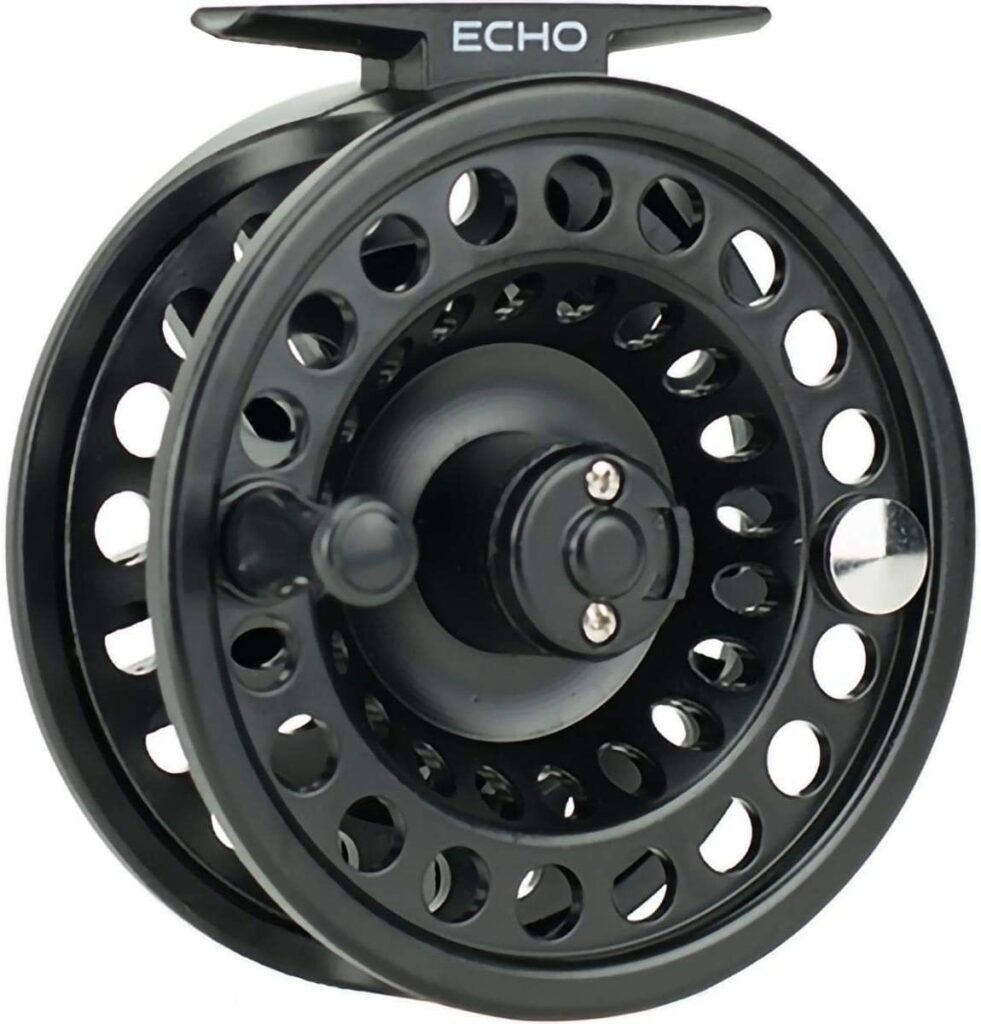
Specs: Three sizes available: 2/3, 4/5 and 6/8. Left and right hand retrieve are interchangeable. 12 month limited warranty.
Why we picked it: The Echo Base is a great choice for beginner fly anglers. It’s designed to be lightweight and durable, making it easy to use and transport. The reel features an adjustable drag system that allows you to customize the tension of your line, giving you more control over how much pressure is applied when casting or retrieving.
The size of the Echo Base also makes it ideal for smaller hands or those who don’t want something too bulky in their hand while fishing. The material used in this reel is aluminum, which gives it strength without adding extra weight. This makes it perfect for long days on the water as well as short trips where you need something light but still reliable enough to get the job done. We recommend sizing up on this reel. If you’re after trout you can consider using the 6/8 on your #5/6 rod. In our test, we found it to better balance a modern trout rod.
The arbor size is also large enough so that you can easily store a lot of line on your spool without worrying about tangles or knots forming during retrieval. Additionally, its corrosion-resistant finish ensures that your reel will last longer even if exposed to saltwater environments on occasion.
Pros:
-
Great value for money
-
Drag system is surprisingly smooth and has literally no startup inertia
Cons:
-
Sizes tend to be on the smaller end. We recommend sizing up
-
This is a freshwater reel, not meant for heavy saltwater use
Piscifun Sword
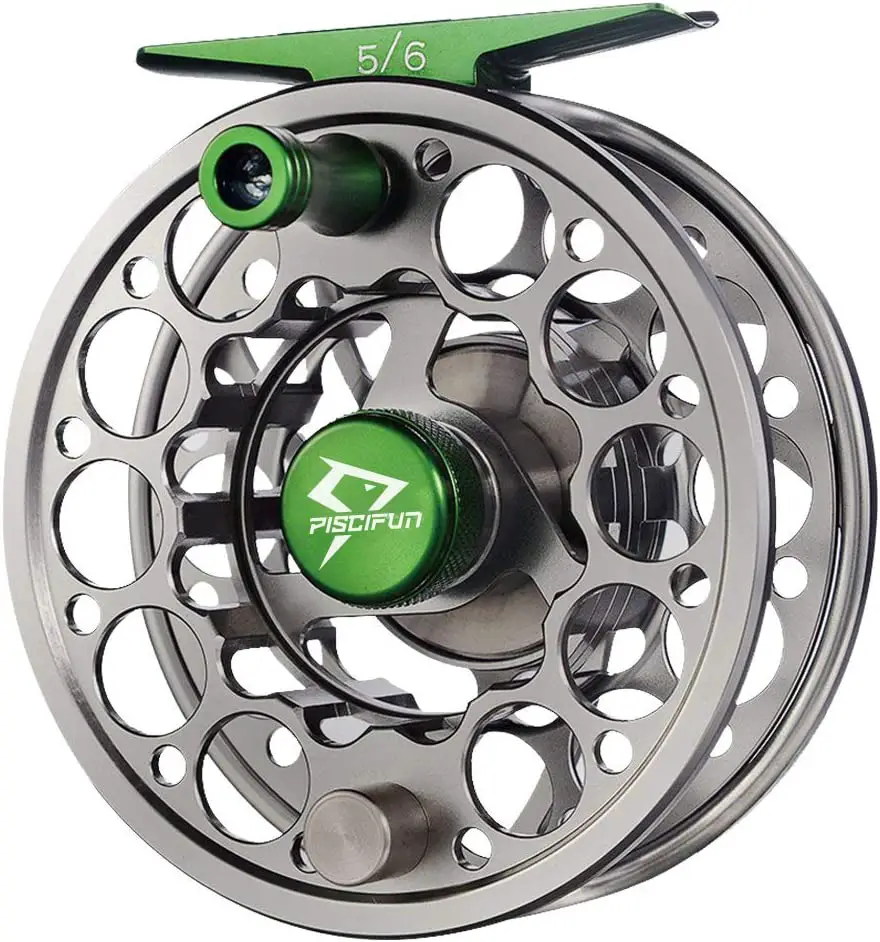
Specs: Comes in five sizes from 3/4 all the way up to 9/10 and four different color options
Why we picked it: The Piscifun Sword is a quality entry level option for beginner fly fishers that features a modern design. It has all the features you need to get started in the sport, without breaking the bank. The Piscifun Sword comes with an aluminum frame and spool that are lightweight yet strong enough to handle large fish. Its drag system is smooth and reliable, making it easy to adjust tension as needed while fishing.
The arbor size of the Piscifun Sword is also generous, allowing for more line capacity than most other reels on the market today. One of its best features in my eyes is its corrosion resistance; thanks to its stainless steel construction, you won’t have to worry about rust or damage from occasional saltwater use (make sure to rinse the reel properly afterwards). This makes it perfect for those who plan on taking their fly fishing trips out into open water where they may encounter salty conditions.
Additionally, this reel can accommodate a variety of line classes – from light trout lines up through heavier bass lines – so no matter what species you’re targeting, you can be sure your setup will be ready for action!
Pros:
-
Great variability in terms of sizes and colors
-
Lightweight and durable
-
Three year warranty
Cons:
-
Switching from left to right hand retrieve is a bit tedious on this reel
-
Drag system could use a fine tuning in terms of adjustment
Lamson Liquid
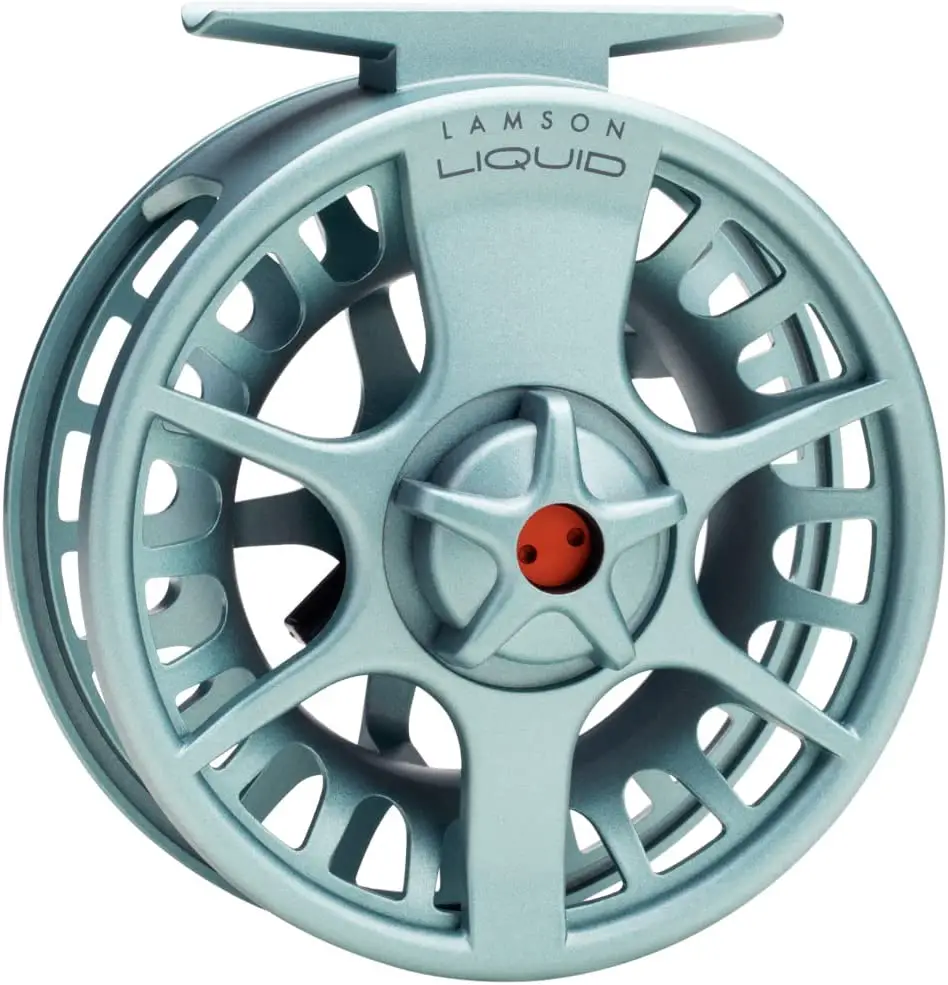
Specs: Available in two colors and three sizes from 2/3 to 8/10. Large arbor design, made from aluminum.
Why we picked it: The Lamson Liquid is a great choice for beginner fly fishers looking to get the most out of their fishing experience. This reel is lightweight, durable and easy to use, making it perfect for those just starting out in the sport. It features an adjustable drag system that allows you to customize your line tension according to the type of fish you’re targeting and its size class. The reel also has a large arbor design which helps with quicker line retrieval and more efficient casting.
The Lamson Liquid is made from high-grade aluminum which makes it both strong and corrosion resistant. Its frame is machined from bar stock aluminum for extra strength while still being light enough so as not to weigh down your rod or arm during long days on the water. Additionally, this reel comes with a lifetime warranty so you can rest assured knowing that if anything goes wrong, Lamson will take care of it right away! In my eyes that’s an invaluable feature – particularly when starting out.
Pros:
-
Fantastic lifetime guarantee
-
Ready for saltwater use
-
Very fast line pickup thanks to the large arbor design
Cons:
-
In our test, the startup inertia was not the best and most reliable on the Lamson
Greys Fin
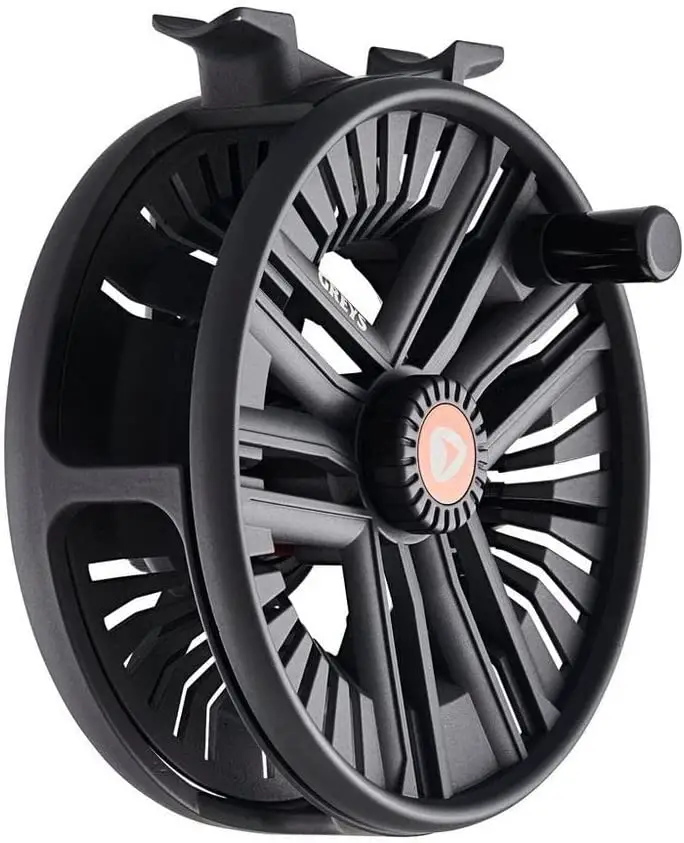
Specs: Comes in four weight options ranging from 3/4 all the way to 9/10. Made from folded aluminum.
Why we picked it: The Greys Fin is the first product from Grey’s brand new line of fly reels. It is lightweight yet durable, making it perfect for long days on the water. The line class of this reel ranges from 3/4 (for small streams and creeks) all the way to 9/10 for taking on big predators like pike or walleye.
The Greys Fin is made out of aluminum which makes it strong enough to withstand tough conditions while still being lightweight enough not to weigh down your rod or slow down your casting speed too much. Additionally, this material provides excellent corrosion resistance so you don’t have to worry about rusting or pitting over time like some reels do with steel construction materials used by competitors..
The Greys Fin also features the brand new disc drag system which provides excellent breaking power – a very nice feature in this price range. Comes with a reel pouch for extra protection.
Pros:
-
Solid disc drag system
-
Wide range of sizes
-
Quick line pickup
Cons:
-
I’ve found the reel seat to not ideally fit into some of the rods we tested this reel on
Cheeky Sighter
Specs: Comes in four sizes (#2/3, #4/5, #6/7 and #8/9) – Price tag: $169-199
Why we picked it: As the last recommendations of our guide, I want to bring you a fly reel that is unlike any other: the Cheeky Sighter (read our in-depth review here). First of all this reel stands out for its colorful design. But that’s not all. From my experience Cheeky fly reels provide excellent value for money. Such is also the case with the Sighter series that starts at $169 (for the #2/3 version). We got our hands on the #8/9 model that is a great choice for most predators in the freshwater such as pike and big bass and even the light saltwater fishery for stripers.
In terms of performance, the Sighter boasts a very strong drag (definitley not something you would expect in this price range). This reel is also very versatile in terms of its line capacity. It will even hold bigger double-handed lines so you use it with your spey rod. As you would expect from a quality fly reel, you can change the retrieve from left to right hand.
Pros:
-
Comes pre-rigged which will safe you time and worries about rigging your reel correctly
-
Easy conversion from left to right hand retrieve
Cons:
-
Drag system is not the best in our test
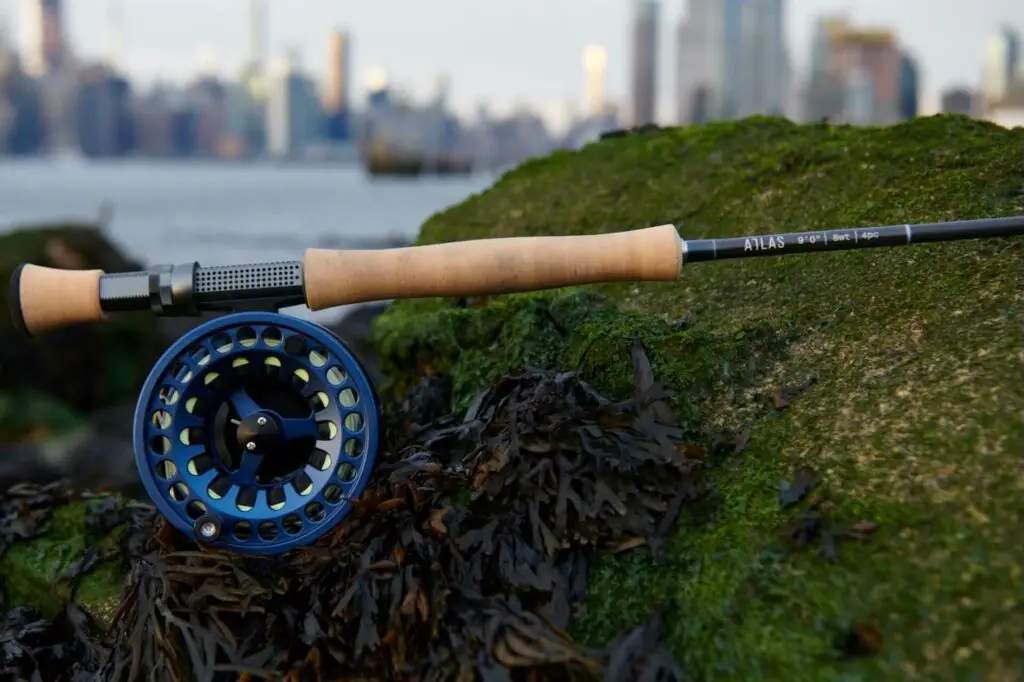
Important Features of Beginner Fly Reels
Now that you have a good overview of some of the best fly fishing reels for beginners, we want to take you by the end to explain the most important features of a quality fly reel such as its size, its drag system and the material its made of.
Reel Size
When selecting a fly reel, size is an important factor to consider. The arbor size determines the amount of line that can be stored on the spool. This is especially important for anglers who fish in areas with lots of vegetation or debris, as more line capacity means fewer tangles and snags. A larger arbor also allows for faster retrieval when playing a large fish. For most beginner anglers, a standard arbor size should suffice; however, those looking to target bigger game may want to opt for a larger one.
When choosing your ideal reel size, keep in mind that “bigger isn’t always better” and there is no use having too much backing if you are only ever going after small trout. The size of the reel is an important factor to consider when selecting a fly fishing reel, as it can have a significant impact on your performance. Next, let’s examine the drag system which enables one to manage the amount of line released from the spool.
Drag System
When it comes to choosing the right drag system for your fly reel, you have two main options: disc drag systems and click and pawl systems.
Disc Drag Systems are designed to provide smooth, consistent pressure throughout the fight with a fish. This type of system is great for those looking to land larger fish, as they can handle more power without sacrificing sensitivity when fighting smaller ones. The way this works is that a set of discs within the reel’s spool apply friction against each other in order to create resistance on the line while you’re fighting a fish. The outer knob of the reel can be adjusted to modify the amount of force being exerted, with a series of discs within its spool providing resistance while battling aquatic creatures.
Click and Pawl Systems offer more control over how much pressure is applied at any given time than disc drag systems do. These reels feature an internal spring-loaded mechanism that clicks when tension increases beyond what has been pre-set by adjusting a knob located on top of the spool housing or inside its side plate (depending on which model). By listening carefully for these clicks during battle with your catch, you can quickly react and reduce tension if needed – making them ideal for anglers who prefer precise control over their drags. Not as powerful as disc reels, yet they offer great precision – a real boon for anglers who need exact control over their drags.
At the end of the day, both types of drag systems have their own unique advantages so ultimately it comes down to personal preference as well as what kind of fishing conditions you plan on tackling most often with your setup. Hence, careful consideration should be taken when selecting the drag system that best suits your needs to avoid any regretful decisions later on.
The drag system is a critical component of any fly reel and should be chosen carefully to ensure the best performance in all conditions. When selecting a new fly reel, the material it is made of should also be taken into account for optimal performance.
Key Takeaway: Fly fishing enthusiasts have two main drag system options to choose from: disc drag systems, which offer more power but less control; and click and pawl systems, which provide greater accuracy even if they can’t handle as much pressure. Ultimately, it’s a matter of individual inclination – don’t overthink it.
Material of the Reel
For those looking to save money and/or reduce the weight of their gear, aluminum fly reels offer a viable option. Aluminum reels are lightweight and relatively affordable, making them an ideal choice for those on a budget or looking for a more portable option. Steel reels, while providing strength and durability, may not be as capable of enduring corrosion over the long-term when compared to titanium or aluminum models. Steel reels provide great strength and durability but come with the downside of being heavier than their aluminum counterparts. Titanium reels, offering corrosion resistance and enhanced durability with a light weight advantage over other materials, have become the go-to choice in recent years.
Aluminum fly reels are typically made from aircraft-grade aluminum which offers excellent strength while remaining lightweight at the same time. This makes them perfect for anglers who want something that’s easy to carry around without sacrificing quality or performance. They also tend to be quite affordable when compared with other materials like steel or titanium so they’re often the go-to choice for beginner anglers who don’t want to break the bank getting started in fly fishing. However, they may not stand up as well over time if you plan on using your reel frequently in saltwater environments where corrosion can quickly take its toll on lesser metals like aluminum alloys.
Steel fly reels offer great strength and durability which makes them ideal for anglers who will be using their gear regularly in harsh conditions such as saltwater fishing trips or heavy freshwater use like chasing big trout out West year after year. The downside of steel fly reels is that they are typically much heavier than other materials, so if portability matters to you, then it might be wise to consider a different material unless you don’t mind carrying some extra weight on your fishing trips. Additionally, steel does require regular maintenance (like oiling) in order maintain its peak performance level over time – something else worth considering before investing in this type of reel material if you’re short on free time.
Titanium fly reels have been gaining popularity recently due to their superior corrosion resistance and lighter weight than both aluminum and steel models. This improved performance comes at a cost, however; expect prices significantly higher than either aluminum or steel models depending on the brand and model you choose.
Key Takeaway: Fly reels are accessible in a mixture of materials, like aluminum for lightweight and economical alternatives; steel to guarantee robustness and longevity; or titanium which is both rust-resistant and light. Depending on your budget, the type of environment you’ll be fishing in, as well as how often you plan to use it – there’s an option out there that can fit any angler’s needs.
Conclusion on Starter Fly Reels
Deciding on the perfect initial fly reel can be intimidating, but it doesn’t have to be. By understanding your line class, selecting an appropriate size of reel for the species you are targeting and considering factors such as drag system, material of the reel and arbor size you can make sure that your first foray into fly fishing is enjoyable and successful. With so many great options available on the market in 2025 there’s never been a better time to get started with starter fly reels.
If you’re looking for the best beginner fly reel to get started with, The Wading List is here to help. Our comprehensive reviews will provide you with all the information needed to make an informed decision.
FAQs on the Best Beginner Fly Reels
What features should I look for in a beginner fly reel?
Look for a reel with a large arbor design for quick line retrieval, a durable construction, and a reliable drag system. Ease of use and maintenance are also crucial for beginners.
Do I need an expensive fly reel as a beginner?
While high-end reels offer advanced features, there are quality beginner reels available at more affordable prices. Focus on a reel that meets your skill level and intended use rather than solely on price.
Is a disc drag or click-and-pawl system better for beginners?
Both drag systems have their advantages. Disc drags provide more control over fighting fish, making them suitable for various situations. Click-and-pawl systems are simpler and may be preferred by those looking for a traditional feel.
What weight reel should I choose for my fly rod?
Match the reel weight to your fly rod. For example, if you have a 5-weight fly rod, choose a 5-weight reel. This ensures balance and optimal performance.
Can a beginner use a large arbor reel?
Yes, beginners can use a large arbor reel. In fact, large arbors offer advantages such as quick line pickup and reduced line memory, making them user-friendly for those new to fly fishing.
How important is the material of the fly reel?
The material of the fly reel affects its durability and weight. Materials like aluminum are common for their strength and lightness. Choose a reel made from quality materials to ensure long-lasting performance.
Should I consider reel maintenance as a beginner?
Yes, reel maintenance is essential for its longevity and smooth operation. Beginners should learn basic maintenance tasks, such as cleaning and lubricating the reel, to keep it in optimal condition. Regular care extends the life of the reel.

